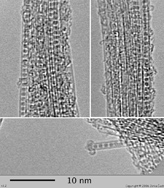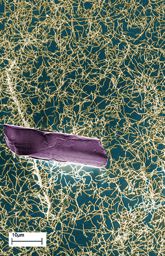Blog-EN
Israel and Palestine
One picture is often worth of thousand words.

Nanoscale Characterization of Modified Carbon Nanotubes
To reveal the answers to some challenging nanotube science questions, we used two powerful electron microscopy methods, Electron Energy Loss Spectroscopy (EELS) and High Resolution Transmission Electron Microscopy (HR-TEM). We successfully resolved and visualized the structure of some chemically functionalized Carbon Canotubes (CNT).
Three selected systems represents the chemically modified CNT. First are surface thiolated MWCNT, second are 'peapods' made by sucking Dy3N@C80 metallo-fullerenes into SWCNT, forming the Dy3N@C80@SWCNT, third, the conventional C60@SWCNT fullerene peapods, fluorinated by Xenon difluoride (XeF2) up to 18% of F. We also achieved detection of very low amount (less than 0.7%) of sulfur and proven the covalent bonding onto surface MWCNT. As the first worldwide we present EELS imaging of the isolated metal atoms inside endohedral metallofulerene peapods. The last of interesting systems is fluorinated C60 peapods, where we show high degree of homogeneous fluorination across whole surface.
I present the results in the EMRS 2006 poster which is free for download and use, as long as you refer to original source and authors of the work.
50.000 times smaller than a Human Hair
I would like to show you a truly beautiful colorized FE-SEM micrograph of sparse network of isolated individual Single Wall Carbon Nanotubes (SWCNT), prepared by CVD using Cobalt nanoparticles as a catalyst and Alcohol as a Carbon Source and grown onto standard Si/SiO2 chips.
They really are beautiful: just as optical fibers have both a practical use for http://www.o2.co.uk/ and are really nice to look at, these nanotubes should have huge practical impacts on the way we live, but are pretty in to the bargain. For synthesis I used a mixture of argon and hydrogen as a carrier gas, normal tube furnace with the temperature of substrate close to 900 °C. Chemical Vapor Deposition (CVD) is simple and versatile technique for nanotube synthesis and such networks shows excellent conductivity, transparency and flexibility.
Note that prepared carbon nanotubes have diameter approximately 1-2 nm, a way below the resolution limit of most SEM machines, but the reason, why you actually can see them is because I used special conditions, which allows charging of the nanotubes in the network. I used the excellent Zeiss Ultra 55 microscope, and the artificial purple and yellow colors are added solely for an aesthetic impression, they have no physical meaning.
The hair fragment on the picture is probably mine, since it is very damaged, broken and brittle. It's also slightly thinner than usual hair.
The nanotube sample was prepared with Alberto Ansaldo, following his scientific paper Alberto also did the false colors for my grayscale microscope photograph of nanotube network and hair.
Funny Lesson In Political Science
Lets explain how does the world actually works in funny way using only cows…
Cows-Lesson-In-Political-Science.pdf
Text Ad: One of the most important aspects of your early education is science. While political science may not be the same type of science as chemistry, biology, or Earth science, it definitely takes a lot of work to try and understand the political landscape.
Support Denmark!

Traditionally, Islam divides known world into two parts, one where they have full control and which they call dar al-Islam meaning 'Land of submission' and other one which is yet to be conquered and which they call dar al-Harb or 'Land of War'


